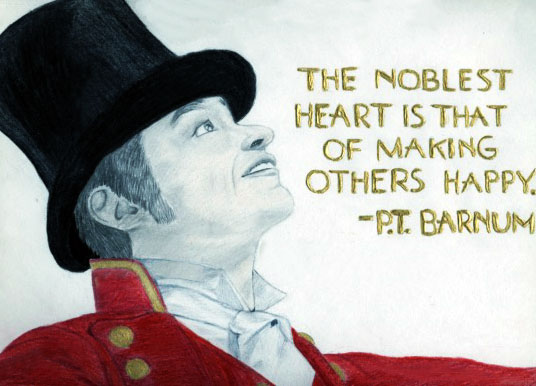Greatest Showman: a celebration of diversity?

Drawing by Grace Sandau
The Greatest Showman was nominated for an Academy Award for the best song, “This Is Me” but lost to Coco’s “Remember Me” on March 4. It also earned $345.4 million at the box office. The Greatest Showman is the story of PT Barnum who introduced a new form of entertainment which was the original Barnum and Bailey museum, in the 1850s, and while the movie presented upbeat dancing and catchy, original music, it lacked in tangible ideas. It addressed controversial topics but downplayed them in order to maintain a childlike perspective and understanding of the world. The film could have addressed racism and discrimination in more powerful way but strayed from doing so–a disappointment for the older audience yet perfect for children.
The movie starts with the childhood of Barnum, played by Hugh Jackman, and the poverty he experiences. It is his unfortunate past that gives him the motivation to be successful. He is driven to prove wrong the people who look down on him. This overbearing pride and need to be right, later turn out to be his downfall. Barnum originally has the business idea to open up a wax museum, which later turns into a circus, or according to other people, a “freakshow.” Barnum brings together the “freaks” of the 1800s such as Lettie Lutz, a bearded lady played by Keala Settle, Charles Stratton, a man with dwarfism played by Sam Humphrey, the tattooed man, played by Shannon Holtzapffel, Anne Wheeler a trapeze artist played by Zendaya, and many more. Unfortunately, Barnum also sells lies as he promotes and portrays false concepts in order to receive a larger audience. After exploiting the people’s diversity for attention and profit he becomes ashamed of them. Ironically, even though Barnum used the people for his own gain, the movie tries to also show that he gives them a voice and somewhere to belong. The is the message that it fails to fully explore.
At times, elements were added to the plot without an explanation, such as the sudden appearance of animals including elephants, giraffes, and lions. This would be a bigger issue if the movie weren’t a musical, but it tends to correspond with the musical outbursts and event changes. As Barnum’s carnival grows in popularity, so does its controversy. Spectators are either enamored by the performance or disgusted by the diversity, since it took place during a time different cultures, races, and ideas weren’t widely accepted. Barnum defends his show and the performers until he is consumed by fame and wealth, and eventually turns his back on them. Karma is soon displayed when a group of people burn down his museum and he is forced to build back up from the bottom which helps him realize his faults. The movie’s attempt to bring in the conflict of diversity is a major part of the plot. Which makes the The Greatest Showman more than an entertaining movie but one with moral structure.
The Greatest Showman can be enjoyed by both children and adults. For people looking for a message, the film delivered a deeper meaning in regards to the damage of mishandling success and other present controversies such as discrimination. For kids the movie was entertaining and the music was catchy. I was very impressed by the production of the movie, the cast and the music. Yet, I felt that the film really capitalized on Zendaya and Zac Efron in order to promote ticket sales. Their parts weren’t as momentous as suggested in the trailers. The greatest elements of the movie were the music and choreography. Each step flowed perfectly into the next. The time period was portrayed believably well in both costumes and behaviors portrayed by the actors. I would definitely recommend it for families and for those who love musicals.







